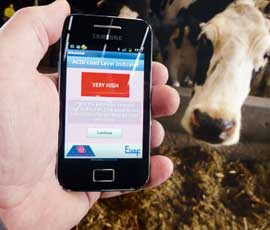VIDEO: New app to measure forage acid loading

A new free app will allow dairy and other ruminant livestock farmers to quickly assess the rumen acid load coming from their forages and so more easily mitigate the risk of acidosis in their stock.
The Alkalator App from FiveF allows farmers to key in their latest forage analyses and establish the fermented crop’s base acid loading effect – be it very high, high, medium or low.
“Acidosis affects most herds in the UK and is a major cause of sub-optimal cow performance. It is caused by the rumen acid loading effect of the ration being fed to the cow, but until now farmers have not had a quick and easy way of assessing the base acid load coming from their forages,” says Malcolm Graham from FiveF.
“When you get your silage analysis and perhaps see that the pH in the clamp is only 0.2 or 0.3 percentage points lower than last year, it would be easy to view this as relatively insignificant. But it’s important to remember that pH is measured on a log scale, and although 3.8 may not look much different to 4.1, for example, it actually means there’s an awful lot more acid around. In fact, in this pH range, the amount of acid potentially going into the rumen approximately doubles with every 0.3 points on the pH scale. And the acidity is in the water fraction, so a 25% dry matter silage has 15% more acid than one at 35% dry matter, even at the same pH,” he says.
“But once you have a better appreciation of the base acid load from your forages, you can then take the necessary steps to neutralise the damaging effect in the rumen before it happens, by formulating in levels of an alkaline dietary component, such as AlkabupHa, or feeding more alkaline forages such as alkalage or alkagrain.”
The Alkalator App is free and runs on Android mobile phones, as well as being available as a download file from the FiveF website. The company is also planning to develop iPhone and web-based emulator versions of the new app. More information is available from the FiveF stand (FF407) at Livestock 2012.
